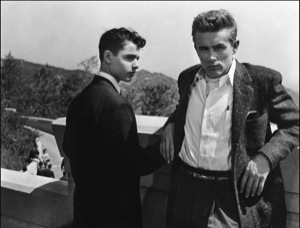
Americans love movie stars. They cheer them on during their rise to stardom. Then they love to tear them down and see them fail. Such is the case with a former teen idol, profiled in a stunning new book Sal Mineo: A Biography, by Michael Gregg Michaud. In Mineo’s case, he may have been his own worst enemy. The book details every triumph and setback in Mineo’s short film career.
Rocketing to stardom as Plato in the iconic teen-angst film of 1955, Sal Mineo became the first actor to portray a gay teenager in Rebel Without A Cause. Mineo became known for his sensitive portrayal of a boy who worshipped James Dean in a love triangle with Natalie Wood. She loved Dean and so did Mineo.
It was the first time overt boy-boy love was shown on American screens. Homosexuality was taboo in those days, so the portrayal had to be done in a subtle and appealing way. Mineo, age 16, being a soulful actor, was so good that he was nominated for a Best Supporting Actor Oscar, the youngest actor to that point to be so honored.
Mineo was born in the Bronx on Jan. 1, 1939 to a casket-making father and loving Italian mother. Author Michaud delved into the family background with many interviews with the Mineos. They were a tightly knit family, and as Mineo grew up, he always relied heavily on his parents and siblings for support.
Showing an early talent for dancing and musical leanings, Mineo got his start on Broadway in a non-musical play by Tennessee Williams, The Rose Tattoo. He then was cast as Yul Brynner’s Prince son in The King and I.
A few roles on television led him to Hollywood, where he made appearances with Tony Curtis in Six Bridges to Cross and Charlton Heston in The Private War of Major Benson. This led to being cast in Rebel and his rise to stardom.
Mineo developed a charm about himself and used his good looks to advantage. He had a tough but vulnerable quality about himself, which served him well in several pictures in which he played juvenile delinquents. Films such as Somebody Up There Likes Me with Paul Newman and Pier Angeli, and Crime In The Streets solidified that image.
Author Michaud details Mineo’s private life as being that of a normal, healthy straight male in his early days. He could have any girl he wanted. He never stuck to any of them until he met British actress Jill Haworth in 1960 on the film Exodus. They carried on until she caught him in bed with a boy. Mineo’s sexual preferences made a massive U-turn as he led a wild and carefree life, jumping into bed with males and females at random.
Mineo’s career spiraled downward, not because of his new-found love of men, but because of poor choices and the fact that his type of movie star was passé.
The book is a fascinating look into the rise and fall of a once wildly popular star. His life was cut short at age 37 by a thief who stabbed the actor to death.
Sal Mineo: A Biography
Author Michael Gregg Michaud
Crown Archetype, Crown Publishing Group
Random House, Inc., New York
421 pages











